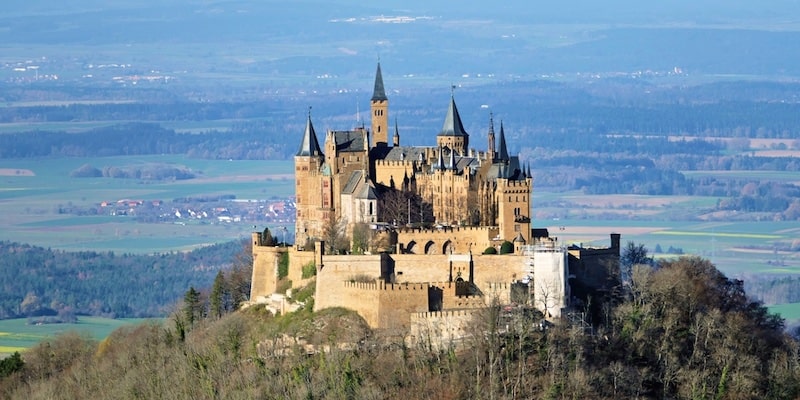We explain what a feudal lord was in the Middle Ages and what the power of ban was. Also, his relationship with serfs and peasants.

What were feudal lords?
Feudal lords were people who belonged to the nobility and had a territory that included a castle, the surrounding land, and the people who lived on it. Feudal lords existed during the Middle Ages and were a social group that appeared within the framework of the political-economic system known as feudalism.
Feudalism was a political, social and economic system that was characterized by the fragmentation of power in small territories dominated by feudal lords. This system existed in Europe between the 9th and 15th centuries, although in some regions it survived until the 18th century.
Each feudal lord owned a fief over which he exercised political, economic and social power. That is, he acted as ruler and made the economic and social decisions that affected the population residing within the fiefdom. This population was made up of peasants who worked the land and gave part of their production to the feudal lord.
The power of the feudal lords was hereditary. Each feudal lord had obtained his power by being the son-heir of the previous feudal lord of a fief. The first feudal lords were appointed by kings which granted them a fief and the power to govern and administer the work of their lands. In exchange, the feudal lords had to defend the kingdom against various dangers.
This way, a noble warrior became a vassal of the king in exchange for a fief. In turn, feudal lords could have minor vassals, who were other feudal lords to whom they granted a portion of the fief in exchange for military and political loyalty.
See also: Feudal mode of production
Privileges of feudal lords
The feudal lords were a privileged social group. They constituted a caste of noble warriors whose main function was to militarily defend the fiefdom that had been granted to them by a king. In exchange, the feudal lords held the power of ban or power of command: each feudal lord could govern within his jurisdiction.
Therefore, The lords had power over the peasants who lived in the fief. They could give them orders and dispense justice. Furthermore, they were the owners of almost all the territory and demanded that the peasants pay taxes in work and in kind.
The feudal lords lived in the castles of their fiefs with their families and a small court. They obtained their resources through the exploitation of the work of the peasants of the fiefdom, so they did not have to work. They had a good quality of life and could access luxury goods.
Relations between feudal lords
Some feudal lords were more powerful, owners of large armies at the service of the king (who in practice was another feudal lord). Others, of lesser power, were in turn subject to other stronger lords, in a pyramidal system, with the king at the head.
The relationships between the different feudal lords were crossed by feudal-vassallic ties. Two nobles established a pact with each other, in which one was the lord and the other was the vassal. The lord, who was the nobleman with the greatest power, undertook to protect his vassal militarily and gave him a fief. In exchange, the vassal promised loyalty to his lord through an oath of fidelity.
| Mutual commitments between lords and vassals | |
|---|---|
| Vassal commitments: – Guarantee loyalty and fidelity to the Lord. – Be part of his court. – Provide military aid. – Provide financial help on specific occasions. |
Lord's commitments: – Protect the vassal and his family. – Give him a fief. – Educate the vassal's son in his own court. |
Lay and ecclesiastical feudal lords
Feudal lords could be lay or ecclesiastical. The lay lords were nobles whose lineage was associated with landowning families of the kingdoms of the past. The status of nobility was hereditary and was only obtained through ties of blood.
The lay nobility had to fulfill security functions. The feudal lord and his entourage constituted a group of knights and had to be prepared for combat in the event of war.
The ecclesiastical lords were members of the Christian Church who also owned lands as fiefs. They were mostly part of the regular clergy; That is, they belonged to religious orders and lived in monasteries or abbeys.
The highest ecclesiastical authority of the fief served as feudal lord in the same way as the lay lords did.
Feudal lords and serfs
The feudal lords ruled over all the inhabitants of their fiefdom The population of the fiefdom was made up of peasant families. Each family unit worked the lands that the feudal lord had granted them for their usufruct and, in addition, they worked the “lordly lands”, whose production remained in the hands of the lord.
Feudal peasants were serfs. This means that they were neither free nor slaves. The serfs owed a debt to the feudal lord and were not free to live in another territory. The condition of being a serf was also hereditary and could only be annulled by the feudal lord.
The feudal lords benefited from this unequal bond since it allowed them to appropriate the product of peasant labor. For their part, they were responsible for the safety and survival of the peasants.
The properties of feudal lords
Each feudal lord had his fief and administered it for his survival and that of all the inhabitants. The basis of the feudal economy was agriculture. Agrarian production was organized around the manor, which was the territory that included crop lands and communal lands (which were forests, rivers and grazing areas).
The most fertile lands were reserved for the feudal lord and constituted the “lordly reserve.” The rest of the farmland was divided into “mansos” and granted to peasant families for their usufruct.
document.addEventListener(“DOMContentLoaded”, (e) => {
var sliderContainer, slider;
sliderContainer = document.getElementById(‘block_c85788f64e830ced575e3d4a9bc6a4b0’);
if (typeof initSlider !== ‘function’) {
console.log(‘Swiper haven\’t been loaded’);
sliderContainer.className += ‘ fw scroll-snap’;
return;
};
options = {
direction: ‘horizontal’,
speed: 1000,
slidesPerView: ‘auto’,
// slidesPerGroup: 1,
centerInsufficientSlides: true,
// centeredSlides:true,
spaceBetween: 15,
breakpoints: {
720: {
// centeredSlides: false,
// slidesPerGroup: 2,
spaceBetween: 25
},
},
pagination: {
el: ‘.swiper-pagination’,
type: ‘bullets’,
clickable: true
},
}
slider = initSlider(sliderContainer, options);
})
References
- Ackermann, M.E., Schroeder, M.J., et al. (2008). “Feudalism: Europe”. Encyclopedia of World History. Vol II. Facts on File.
- Marx, K. (1990). Contribution to the critique of political economy. 21st century.
- Marquez, M and Cassano, K. (2010). “Feudalism.” Social Sciences 1. Cassava.
- Rojas, CAA (1986). The feudal mode of production. Mexican Journal of Sociology27-85.





